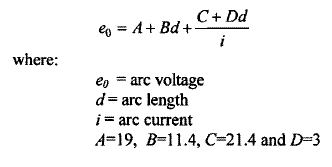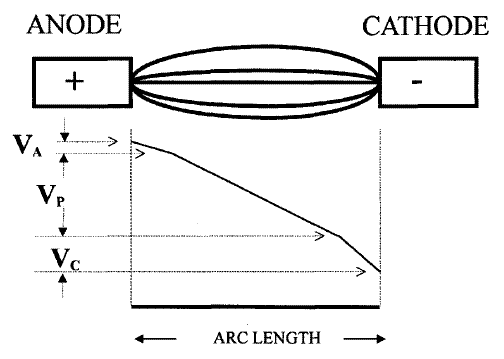Generally yes, of course it is related to contact surface current density. The voltage drop across the positive column of the arc is characterized by a uniform longitudinal voltage gradient. Its magnitude, in the case of an arc surrounded by a gaseous environment, depends primarily on the type of gas, the gas pressure, the magnitude of the arc current, and the length of the column itself. For the positive column gradient, voltage values ranging from only a few volts per centimeter to several hundred volts per centimeter have been observed. The first extensive study of the electric arc voltage relationships, for moderate levels of current and voltage, was made by Hertha Ayrton, who developed a formula defining the arc voltage on the basis of empirical experimental results. The relationship is still considered to be valid and is still widely used, although within a limited range of current and voltage. The classical Ayrton equation is given as:  The values of the constants A, B, C, and D are empirical values for copper electrodes in air. The current density at the cathode is practically independent of the arc current, but it is strongly dependent upon the electrode material.
The values of the constants A, B, C, and D are empirical values for copper electrodes in air. The current density at the cathode is practically independent of the arc current, but it is strongly dependent upon the electrode material.  In refractory materials that have a high boiling point, such as carbon, tungsten, or molybdenum the cathode spot is observed to be relatively fixed. The cathode operates by thermionic emission and its current density is in the order of l03 amps per cm2. The “cold cathode arc” is characteristic of low boiling point materials such as copper and mercury. The cathode spot in these materials is highly mobile, it operates in some form of field emission, and its current density is in the order of 106 to 107 amps per cm2. In those materials that have a low boiling point, a considerable amount of material is melted away from the electrodes. The material losses of refractory materials are only due to vaporization. Under identical arcing conditions the refractory material losses are considerably less than the losses of low boiling point materials, and consequently this constitutes an important factor that must be kept in mind when selecting materials for circuit breaker contacts.
In refractory materials that have a high boiling point, such as carbon, tungsten, or molybdenum the cathode spot is observed to be relatively fixed. The cathode operates by thermionic emission and its current density is in the order of l03 amps per cm2. The “cold cathode arc” is characteristic of low boiling point materials such as copper and mercury. The cathode spot in these materials is highly mobile, it operates in some form of field emission, and its current density is in the order of 106 to 107 amps per cm2. In those materials that have a low boiling point, a considerable amount of material is melted away from the electrodes. The material losses of refractory materials are only due to vaporization. Under identical arcing conditions the refractory material losses are considerably less than the losses of low boiling point materials, and consequently this constitutes an important factor that must be kept in mind when selecting materials for circuit breaker contacts.

 The values of the constants A, B, C, and D are empirical values for copper electrodes in air. The current density at the cathode is practically independent of the arc current, but it is strongly dependent upon the electrode material.
The values of the constants A, B, C, and D are empirical values for copper electrodes in air. The current density at the cathode is practically independent of the arc current, but it is strongly dependent upon the electrode material.  In refractory materials that have a high boiling point, such as carbon, tungsten, or molybdenum the cathode spot is observed to be relatively fixed. The cathode operates by thermionic emission and its current density is in the order of l03 amps per cm2. The “cold cathode arc” is characteristic of low boiling point materials such as copper and mercury. The cathode spot in these materials is highly mobile, it operates in some form of field emission, and its current density is in the order of 106 to 107 amps per cm2. In those materials that have a low boiling point, a considerable amount of material is melted away from the electrodes. The material losses of refractory materials are only due to vaporization. Under identical arcing conditions the refractory material losses are considerably less than the losses of low boiling point materials, and consequently this constitutes an important factor that must be kept in mind when selecting materials for circuit breaker contacts.
In refractory materials that have a high boiling point, such as carbon, tungsten, or molybdenum the cathode spot is observed to be relatively fixed. The cathode operates by thermionic emission and its current density is in the order of l03 amps per cm2. The “cold cathode arc” is characteristic of low boiling point materials such as copper and mercury. The cathode spot in these materials is highly mobile, it operates in some form of field emission, and its current density is in the order of 106 to 107 amps per cm2. In those materials that have a low boiling point, a considerable amount of material is melted away from the electrodes. The material losses of refractory materials are only due to vaporization. Under identical arcing conditions the refractory material losses are considerably less than the losses of low boiling point materials, and consequently this constitutes an important factor that must be kept in mind when selecting materials for circuit breaker contacts.